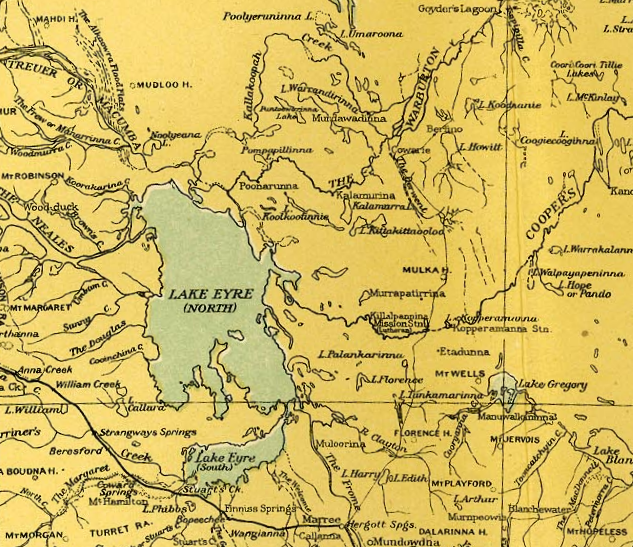Lake Ngapakaldi on:
[Wikipedia]
[Google]
[Amazon]
__NOTOC__
 The Lake Ngapakaldi to Lake Palankarinna Fossil Area is a group of fossil sites located in the Australian state of
The Lake Ngapakaldi to Lake Palankarinna Fossil Area is a group of fossil sites located in the Australian state of
 The Lake Ngapakaldi to Lake Palankarinna Fossil Area is a group of fossil sites located in the Australian state of
The Lake Ngapakaldi to Lake Palankarinna Fossil Area is a group of fossil sites located in the Australian state of South Australia
South Australia (commonly abbreviated as SA) is a state in the southern central part of Australia. It covers some of the most arid parts of the country. With a total land area of , it is the fourth-largest of Australia's states and territories ...
within the Tirari Desert
The Tirari Desert is a desert in the eastern part of the Far North region of South Australia. It stretches 212 km from north to south and 153 km from east to west.
Location and description
The Tirari Desert features salt lakes and ...
in the north-eastern part of the state's Far North region. The group has an overall area of and is located about east of Lake Eyre
Lake Eyre ( ), officially known as Kati Thanda–Lake Eyre, is an endorheic lake in east-central Far North South Australia, some north of Adelaide. The shallow lake is the depocentre of the vast endorheic Lake Eyre basin, and contains th ...
and about north-north-east of Marree, off the Birdsville Track
The Birdsville Track is a notable outback road in Australia. The track runs between Birdsville in south-western Queensland and Marree, a small town in the north-eastern part of South Australia. It traverses three deserts along the route, the St ...
near Etadunna Station.
Description
The area consists of four lakes grouped into two areas located about apart. They are surrounded by extensive areas of sand dunes in a flat, arid landscape. The lake beds are largely unvegetated and usually dry. Low cliffs on the western margins of the lakes have produced a variety ofTertiary
Tertiary ( ) is a widely used but obsolete term for the geologic period from 66 million to 2.6 million years ago.
The period began with the demise of the non-avian dinosaurs in the Cretaceous–Paleogene extinction event, at the start ...
vertebrate
Vertebrates () comprise all animal taxa within the subphylum Vertebrata () (chordates with backbones), including all mammals, birds, reptiles, amphibians, and fish. Vertebrates represent the overwhelming majority of the phylum Chordata, with c ...
fossils ranging in age from the late Oligocene to the Pleistocene
The Pleistocene ( , often referred to as the ''Ice age'') is the geological epoch that lasted from about 2,580,000 to 11,700 years ago, spanning the Earth's most recent period of repeated glaciations. Before a change was finally confirmed in ...
.
Lakes Kununka, Ngapakaldi and Pitikanta
The following three lakes are located on the west side of the gazetted locality of Mulka with Lake Ngapakaldi being partly located within the locality ofLake Eyre
Lake Eyre ( ), officially known as Kati Thanda–Lake Eyre, is an endorheic lake in east-central Far North South Australia, some north of Adelaide. The shallow lake is the depocentre of the vast endorheic Lake Eyre basin, and contains th ...
:
* Lake Kununka Rich ''et al''. (1982).
* Lake Pitikanta
* Lake Ngapakaldi
Lake Palankarinna
Lake Palankarinna is located in the gazetted locality of Etadunna on the west side of the Birdsville Track to the south of the other three sites. The lake is part of a reserve known as the ‘Lake Palankarinna Fossil Reserve’ which consists of part of the western half of the lake bed and a parcel of land to the west.Status
The four sites are subject to a number of past and present heritage listings while one is located with a protected area: *All four sites were listed as one entity on the now-defunct Register of the National Estate (No.5905) on 21 October 1980.Australian Heritage Database. *Lakes Kanunka, Pitikanta and Ngapakaldi has been listed as state heritage places on theSouth Australian Heritage Register
The South Australian Heritage Register, also known as the SA Heritage Register, is a statutory register of historic places in South Australia
South Australia (commonly abbreviated as SA) is a state in the southern central part of Australia. ...
since 1997.
*Lake Ngapakaldi is also partly located within the Kati Thanda-Lake Eyre National Park.
*Lake Palankarinna and some adjoining land has been gazetted since 1954 as a ‘fossil reserve’ under what is currently known as the ''Pastoral Land Management and Conservation Act 1989'' in order to “prevent the exploitation for profit of these areas by non-scientists.”Morton et al, 1995, page 96 The fossil reserve has also been listed as a ‘state heritage place’ since 1993.
See also
*List of fossil parks
Following is a list of protected areas where fossils are preserved, known as fossil parks or fossil reserves, worldwide by country.
Africa
Egypt
Wadi Al-Hitan - Valley of The Whales, Fayyoum, Western Desert
South Africa
West Coast Fossil Par ...
References
Notes
Sources
* * *Further reading
* Pledge, Neville S.; & Prideaux, Gavin John. (1996). ''The natural history of the Lake Palankarinna fossil reserve''. South Australian Museum: Adelaide. * Oligocene paleontological sites Miocene paleontological sites Pliocene paleontological sites Pleistocene paleontological sites of Australia Ngapakaldi Lake Eyre basin Salt flats of Australia South Australian places listed on the defunct Register of the National Estate Far North (South Australia) Fossil parks in Australia South Australian Heritage Register Cenozoic paleontological sites of Australia Paleontology in South Australia {{Australia-geology-stub